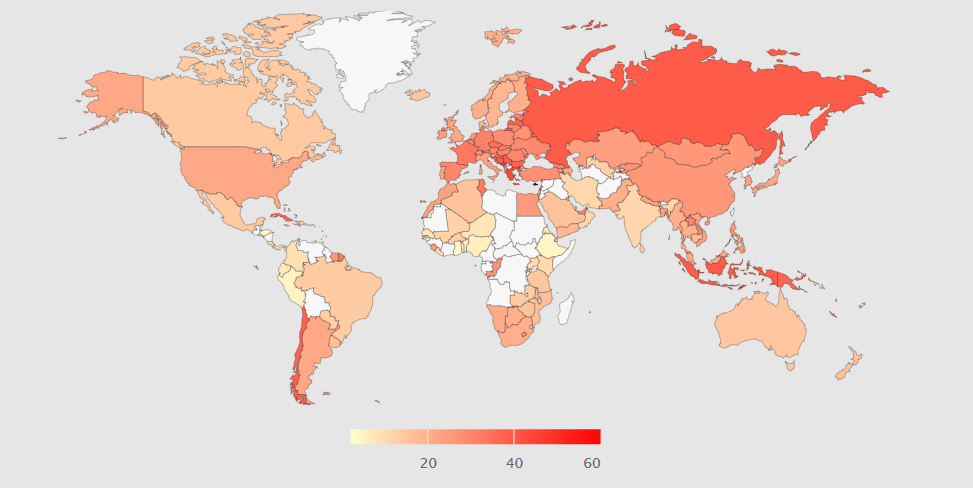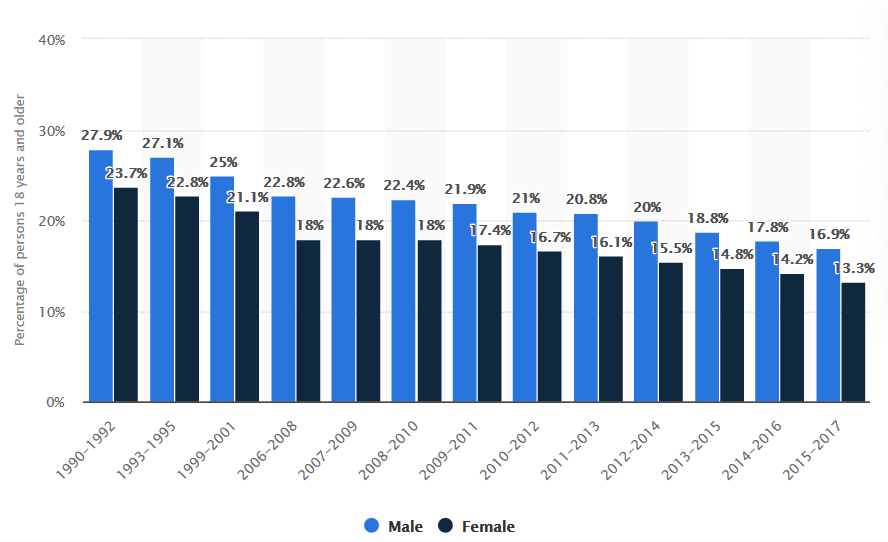Smoking is one of the leading causes of preventable deaths. Smoking directly affects 15% of all deaths. This results that 1 in 6 deaths are because of smoking. It is insane that we lose so many people because of something so trivial. Luckily, people are choosing to be healthier moving forward by reducing smoking. This trend has proven to reverse the negative impact of smoking step-wise and allows you to enjoy the health benefits in less than an hour. It is so successful that millions of people around the world are taking advantage of this opportunity.

This world heat map exhibits the prevalence of smoking as a percentage of 15-year-old’s and over who smoke any tobacco product on a daily or non-daily basis. It excludes smokeless tobacco use. The rates are age-standardized as depicted by the World Health Organisation.
Smoking is practiced by millions of people around the world. Every inhalation of smoke involves a mixture of aerosol particles and gases. This mixture contains a variety of toxic chemicals sent straight to your lungs. After which is absorbed by your bloodstream.

Here is a trend that shows the percentage of male and females above the age of 18 in the US that smoke. This chart shows you a fading smoking trend each year. Thus, millions of lives are saved and in return they bath in the health benefits non-smokers receive. Do you want to know what these benefits are that lead to reversing the side effects that smoking has caused? Keep reading further. Spoiler alert, there is even a time-line to walk you through every stage of the improvements.
- After 20 mins
- After 8 hours
- After 12 hours
- 24 hours after your last cigarette
- 48 hours after your last cigarette
- 72 hours after your last cigarette
- One week after your last cigarette
- Two weeks after your last cigarette
- One month after your last cigarette
- Within three months
- Six months after your last cigarette
- After 9 months
- One year after your last cigarette
- In three years after quitting smoking
- Five years after your last cigarette
- 10 years after your last cigarette
- 15 years after your last cigarette
- After 20 years
- Key takeaway
Every puff you take of that ember lit cigarette is solely your decision. But there is always a flip side to that coin. You could take the brave decision to quit. However, if you have chosen to quit smoking. What can be useful at this moment is to know what to expect if you follow through your decision to exit smoking fully? Let’s start with that timeline, I promised. Since you reached so far, I can confidently tell you that the health benefits start even earlier than an hour of making your decision.
After 20 mins
Smoking has a negative impact upon the blood pressure, rising it. This complements the risk of blood clots and the risk of a stroke. 20 min in and immediately your blood pressure drops and heart rate plummets, as you begin to come back to normal levels your body is used too. It doesn’t stop there.
The lungs begin to remove troublesome bacteria thanks to the fibers in the bronchial tubes that start to move again. These fibers were immobilised due to constant exposure to smoke. Thus saving you from the risk of infections that could arise.
After 8 hours
Until now, you may not have been aware of the toxic chemicals you were inhaling. One of which is called carbon monoxide. Its popularity comes from killing people in their sleep if you have a fire in your house. That’s why you need a fire alarm at home which detects carbon monoxide. Each time you smoke, you are voluntarily poisoning your lungs and bloodstream. Carbon monoxide replaces oxygen particles in the blood, lowering the amount of oxygen your cells receive. Luckily, your carbon monoxide levels drop, moving towards normal levels after 8 hours.
The main reaction to this phenomenon is that your oxygen levels rise. This increased oxygen directly nourishes your cells, tissues and blood vessels you were poisoning 8 hours ago.
After 12 hours
Now, the body has had sufficient time to cleanse itself from any excessive levels of the poisonous carbon monoxide caused by smoking 12 hours ago. In return you are blessed with normalised oxygen levels which is compensated by the loss of carbon monoxide.
24 hours after your last cigarette
Coronary heart disease risks lower because smoking normally decreases the good cholesterol. Therefore, the heart has to work harder to function optimally. Depressing I know, but day one marks the first major milestone. It lowers the risk of a heart attack. Evidently it is because of the continuously boosted levels of oxygen-enriched blood you allowed to enter your heart. The heart returns the favour with improved efficiency. Simultaneously, the nicotine levels in your bloodstream sunk to minimal levels which is excellent news after day one, don’t you agree?
48 hours after your last cigarette
Normally smoking messes up the senses like taste and smell. No extra stem cell therapy required because day 2 initiates the miraculous regrowth of previously damaged nerve endings. The senses smoking put to sleep begin to wake up from hibernation. You may realize you’re smelling and tasting things better than you were before.
72 hours after your last cigarette
Breathe in that fresh air! Because on day 3, you are breathing much more easily. This is because the bronchial tubes inside the lungs have relaxed and opened up more. Translating this means that your lung capacity just increased. No magic trick, simply avoiding smoking can do this for you. Further, this improves air exchange between carbon dioxide and oxygen.
Remember, by this time you might get headaches, feel moody and become irritable. Headaches and craving are on their way. Just be ready for them. They say preparation is half the battle won.
Don’t let those things demotivate you. You are better than that! From removing poisons and toxins for free, to lowering the risk of heart disease while you sleep, regrowing nerve-ending without expensive stem cell therapy and now as a freebie you get an increased lung capacity. All of this in 3 days, well it doesn’t stop there. Keep reading. The blessings have just started.
One week after your last cigarette
If you reached this far means that statistically you have a 90% chance to quit smoking for good. With luck on your side, you don’t need much else. Week 1 is a major milestone in your journey to quitting and each day is a step towards a lifetime of healthy smokeless sunsets.
Two weeks after your last cigarette
Have you noticed that your stance and your walk have improved? Yes, it definitely will. Your body will thank you for giving it a chance to improve its circulation system. And don’t forget about the good oxygen levels which make taking every breathe and every step that much better.
Oh, here is the punchline. Your lungs have not only healed, but that has done so much that your lung function just improved by 30%. You seriously deserve a good pat on the back for reaching this far.
One month after your last cigarette
This is a huge milestone because your energy levels are now hitting the roof thanks to all that oxygen flow you helped set in motion since the last month. In just one short month, you can experience many health changes related to stopping smoking.
Shortness of breath and sinus congestions days are slowly going away. Natural healing of the lungs have lead to the healthy growth of fibers that reduce the excess mucus, build up and shield the lungs against bacterial infections. Say bye-bye to a smoker’s cough because that symptom was just unnecessary, am I right?
Within three months
Who would have thought that smoking also affects fertility. After these 3 months women can improve their fertility and reduce the risk that her baby will be born prematurely. Lungs health keeps blossoming, and the circulation keeps improving. If you’ve reached this far, you know you can feel the difference.
Six months after your last cigarette
After six months of quitting, comes along the ability to handle stressful events that come your way without feeling the need to smoke. Yes, you can do it without lighting up your troubles. So many people do it without a cigarette, you have done well so far don’t give up now. The phlegm and mucus are on the decline because of lower inflammation caused by the harsh chemicals and the smoke.
After 9 months
You could say that your lungs have mostly healed. The delicate, hair-like structures called Cila that lay inside the lungs have recovered from the toll cigarette smoke took on them. Cila is known to push that pesky mucus out of the lungs and help fight infections.
One year after your last cigarette
After one year of quitting smoking, your lungs would have mostly improved and boast increased lung capacity and efficiency. Thus, leading to significantly improved breathing capability when you’re pushing your body further with minimal coughing. This means that coronary heart disease risks have halved.
Have you noticed how much money you have saved this year. Let’s put that to excellent use and save it for a rainy day or invest it somewhere.
In three years after quitting smoking
Now you can compare yourself to a non-smoker because your risk of a heart attack has decreased to that of a nonsmoker. Finally, you are on your way to the green zone. You could say, you are almost in the clear but there is some damage done to other parts of your body which take longer to recover. The body will finally be able to see improvements in those areas too.
Smoking not only limits oxygen flow to the heart, but it builds up the fatty tissue and damages the lining of the arteries. Slowly your body will start improving those arteries too.
Five years after your last cigarette
Five years after you stop smoking, your risk of death from lung cancer has dropped by half compared to when you smoked. That is such relieving news. The body has healed itself enough as the arteries and blood vessels widen again. This improves the blood circulations. You have just leveled up. This is because after 5 years your chances of a blood clot and a stroke have decreased too.
10 years after your last cigarette
At the decade mark, your risk of dying because of lung cancer has decreased to that of a nonsmoker. This is because previously precancerous cells are now replaced with healthy cells. Your risk for getting smoking-related illnesses are declining. This includes a reduced risk for cancers of the mouth, esophagus, kidneys, bladder and pancreas. This is fantastic news.
15 years after your last cigarette
At the 15-year mark, your risk for coronary heart disease, pancreatic cancer, heart attack and stroke has decreased to equal that of a person who’s never smoked before. While it can take time to turn back the clock on the effects of smoking, if you made it this far means that you have achieved a significant milestone in your life.
After 20 years
After 20 years, the risk of death from smoking-related causes, including both illness, infections, diseases and cancer, drops to the level of a non-smoker.
Key takeaway
When you quit smoking, the body heals naturally and regains the vitality of a non-smoker. There is more to gain and nothing to lose if you stay on this journey. It is better for you and the surrounding people.
After going through this, it is a no brainier that quitting is the best option. The benefits only take some time and are free. The process brings more benefits than any medication, therapy or doctor can ever give you, even with the best tools, education and resources money can provide.
I highly recommend seeking support to help you on this journey from a health care professional. Even your local doctor, family members and friends will be there to support you on your path. In this journey you are your best friend and your worst enemy. That is why you shouldn’t go through this alone. Go to your comrades, talk to them about it and take their support.
You deserve the best life has to offer; take all the support you can get. Celebrate each milestone and keep looking forward. Greatness lies ahead for those who persevere, for they shall be rewarded by time and effort they have invested. You are ready to be initiated on this path. Go out there and make yourself proud because you are worth it and you deserve it.



